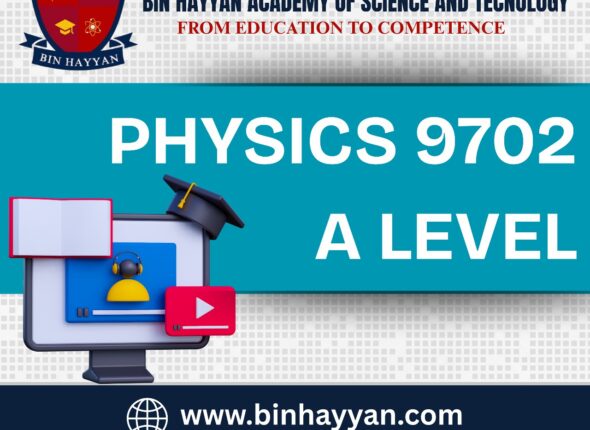No products in the cart.



Candidates study the following topics:
1. Pure Mathematics 1
2. Pure Mathematics 2
3. Pure Mathematics 3
4. Mechanics
5. Probability & Statistics 1
6. Probability & Statistics 2
Course Content
Pure Mathematics 1
-
carry out the process of completing the square for a quadratic polynomial ax 2 + bx + c and use a completed square form. e.g. to locate the vertex of the graph of y = ax²+ bx + c or to sketch the graph
-
find the discriminant of a quadratic polynomial ax² + bx + c and use the discriminant. e.g. to determine the number of real roots of the equation ax²+ bx + c = 0. Knowledge of the term ‘repeated root’ is included.
-
solve quadratic equations, and quadratic inequalities, in one unknown. By factorising, completing the square and using the formula.
-
solve by substitution a pair of simultaneous equations of which one is linear and one is quadratic. e.g. x + y + 1 = 0 and x²+y²=25 2x + 3y = 7 and 3x² = 4 + 4xy.
-
recognise and solve equations in x which are quadratic in some function of x.e.g. x^4 – 5x² + 4 = 0, 6x +√x −1 = 0, tan²x = 1 + tanx.
-
understand the terms function, domain, range, one-one function, inverse function and composition of functions
-
identify the range of a given function in simple cases, and find the composition of two given functions.
-
determine whether or not a given function is one-one, and find the inverse of a one-one function in simple cases.
-
illustrate in graphical terms the relation between a one-one function and its inverse Sketches should include an indication of the mirror line y = x.
-
understand and use the transformations of the graph of y = f(x) given by y = f(x) + a, y = f(x + a), y = af(x), y = f(ax) and simple combinations of these.
-
Including use of the terms ‘translation’, ‘reflection’ and ‘stretch’ in describing transformations. Questions may involve algebraic or trigonometric functions, or other graphs with given features.
-
find the equation of a straight line given sufficient information/ e.g. given two points, or one point and the gradient.
-
interpret and use any of the forms y = mx + c, y – y1 = m(x – x1 ), ax + by + c = 0 in solving problems
-
Including calculations of distances, gradients, midpoints, points of intersection and use of the relationship between the gradients of parallel and perpendicular lines.
-
understand that the equation (x – a)² + (y – b)² = r², represents the circle with centre (a, b) and radius r.Including use of the expanded form x² + y² + 2gx + 2fy + c = 0.
-
use algebraic methods to solve problems involving lines and circles Including use of elementary geometrical properties of circles, e.g. tangent perpendicular to radius, angle in a semicircle, symmetry. Implicit differentiation is not included.
-
understand the relationship between a graph and its associated algebraic equation, and use the relationship between points of intersection of graphs and solutions of equations. e.g. to determine the set of values of k for which the line y = x + k
-
understand the definition of a radian, and use the relationship between radians and degrees
-
use the formulae s=rθ and A=1/2r²θ in solving problems concerning the arc length and sector area of a circle. Including calculation of lengths and angles in triangles and areas of triangles.
-
sketch and use graphs of the sine, cosine and tangent functions (for angles of any size, and using either degrees or radians).Including e.g. y = 3sinx, y=1–cos2x, y= tan (x +1/4π)
-
use the exact values of the sine, cosine and tangent of 30°, 45°, 60°, and related angles e.g. cos150°=-1/2(√3),sin3/4π=1/(√2)
-
use the notations sin–1 x, cos–1 x, tan–1 x to denote the principal values of the inverse trigonometric relations No specialised knowledge of these functions is required, but understanding of them as examples of inverse functions is expected.
-
use the identities cosθ/sinθ=tanθ and sin²θ+cos²θ=1 e.g. in proving identities, simplifying expressions and solving equations.
-
find all the solutions of simple trigonometrical equations lying in a specified interval (general forms of solution are not included). e.g. solve 3sin2x+1=0 for −π<θ<π, 3sin²θ-5cosθ-1=0 for 0<θ<360
-
use the expansion of (a + b)ⁿ, where n is a positive integer. Including the notations (n r) and n! Knowledge of the greatest term and properties of the coefficients are not required.
-
recognise arithmetic and geometric progressions
-
use the formulae for the nth term and for the sum of the first n terms to solve problems involving arithmetic or geometric progressions
-
Including knowledge that numbers a, b, c are ‘in arithmetic progression’ if 2b = a + c (or equivalent) and are ‘in geometric progression’ if b²= ac (or equivalent).
-
use the condition for the convergence of a geometric progression, and the formula for the sum to infinity of a convergent geometric progression.
-
understand the gradient of a curve at a point as the limit of the gradients of a suitable sequence of chords, and use the notations f ′(x), f ″(x), dx/dy , and d²y/dx² for first and second derivatives
-
e.g. includes consideration of the gradient of the chord joining the points with x coordinates 2 and (2 + h) on the curve y = x 3 . Formal use of the general method of differentiation from first principles is not required.
-
use the derivative of xⁿ (for any rational n), together with constant multiples, sums and differences of functions, and of composite functions using the chain rule. e.g. find dx/dy, given y=√(2x³=5)
-
apply differentiation to gradients, tangents and normals, increasing and decreasing functions and rates of change
-
Including connected rates of change, e.g. given the rate of increase of the radius of a circle, find the rate of increase of the area for a specific value of one of the variables
-
locate stationary points and determine their nature, and use information about stationary points in sketching graphs.
-
Including use of the second derivative for identifying maxima and minima; alternatives may be used in questions where no method is specified.
-
understand integration as the reverse process of differentiation, and integrate (ax + b)^n (for any rational n except –1), together with constant multiples, sums and differences. e.g. ∫(2x³-5x+1)dx=∫(1/2x+5)²dx
-
solve problems involving the evaluation of a constant of integration e.g. to find the equation of the curve through (1, –2) for which dx/dy=√2x+1
-
evaluate definite integrals Including simple cases of ‘improper’ integrals, such as ∫ x^-1/2dx,∫x-²dx
-
use definite integration to find – the area of a region bounded by a curve and lines parallel to the axes, or between a curve and a line or between two curves – a volume of revolution about one of the axes.
-
A volume of revolution may involve a region not bounded by the axis of rotation, e.g. the region between y = 9–x² and y = 5 rotated about the x-axis.
Pure Mathematics 2
Pure Mathematics 3
Mechanics
Probability & Statistics 1
Probability & Statistics 2
Student Ratings & Reviews

No Review Yet






